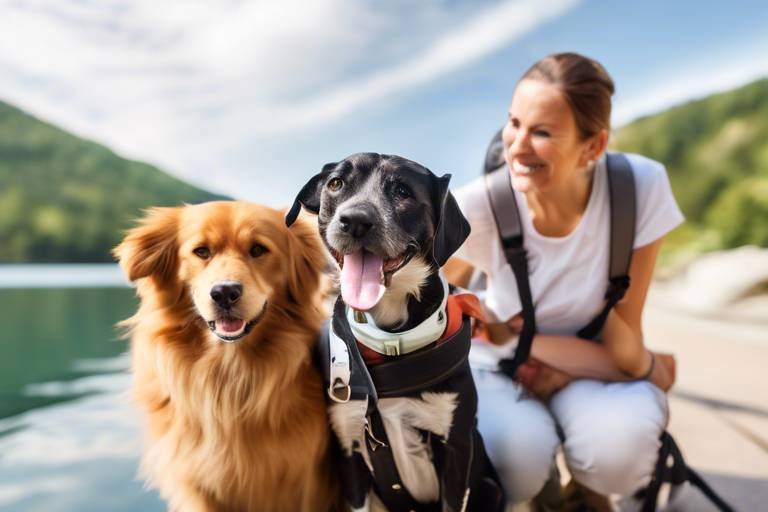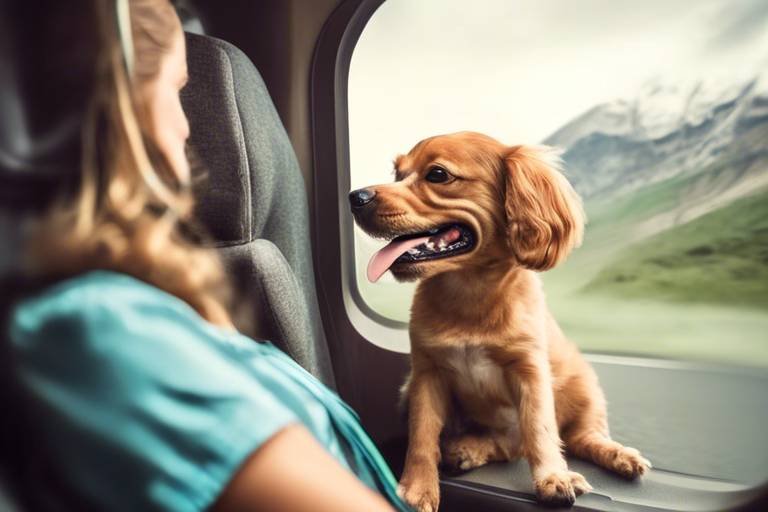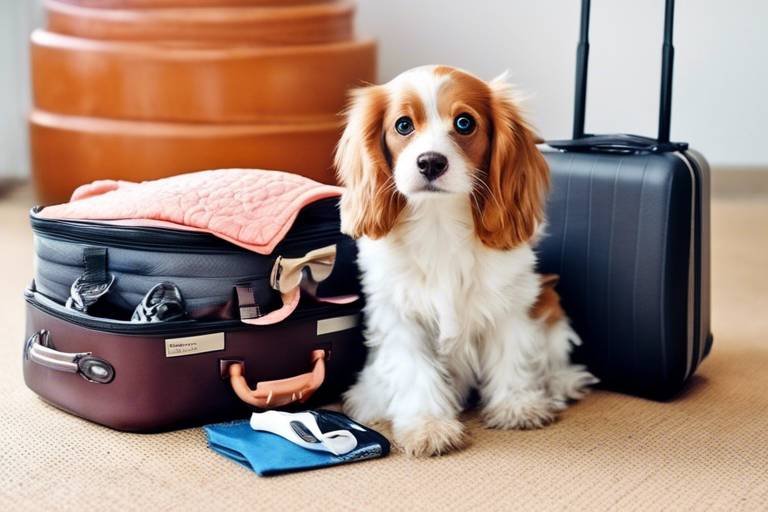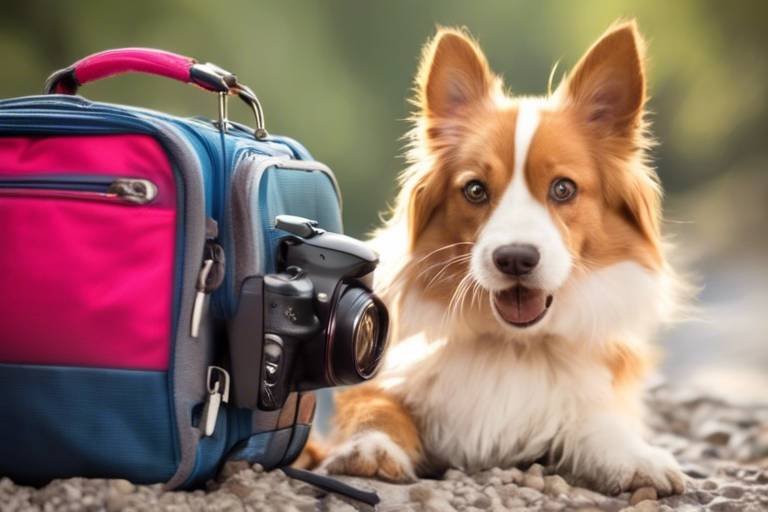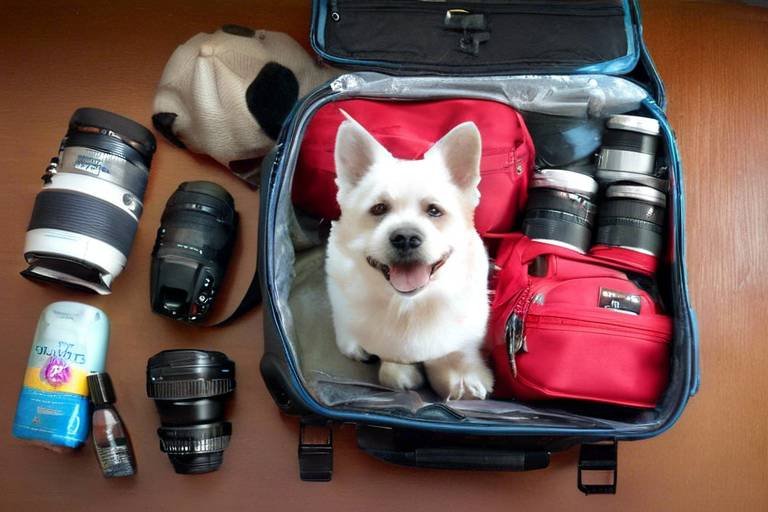Tips for Ensuring Your Pet’s Safety During Outdoor Activities
This article provides essential tips and guidelines to keep your pet safe while enjoying outdoor adventures, ensuring a fun and secure experience for both you and your furry friend. We all love the great outdoors, and our pets do too! But with adventure comes responsibility. Whether you're hiking, running, or just playing in the park, it's crucial to keep your furry companions safe. So, buckle up as we dive into some super helpful tips that will help you create unforgettable memories without compromising your pet's safety.
Every pet has unique requirements. Understanding your pet's specific needs, including exercise levels, temperament, and health considerations, is crucial for planning safe outdoor activities that cater to them. For instance, a high-energy dog like a Border Collie might thrive on long hikes, while a more laid-back breed, such as a Bulldog, may prefer shorter strolls. It's like planning a vacation; you wouldn’t take a beach-loving friend to the mountains without considering their preferences, right? Pay attention to your pet’s behavior and adjust activities accordingly. This will ensure that both you and your pet have a blast while staying safe!
Selecting appropriate and safe locations for outdoor activities is vital. Research parks, trails, and beaches that are pet-friendly and free from potential hazards like toxic plants or aggressive wildlife. A quick online search can reveal dog-friendly spots in your area. Always check reviews and local regulations to ensure that your chosen location is welcoming to pets. Imagine taking your pet to a beautiful park only to find out that dogs are not allowed. What a bummer! So, do your homework and pick spots where your pet can roam freely and safely.
Using the right gear enhances safety during outdoor activities. Invest in quality leashes, harnesses, and safety equipment tailored to your pet's size and activity level to ensure their comfort and security. For example, a sturdy harness can prevent your pet from slipping out during a sudden chase after a squirrel. Additionally, consider reflective gear for evening walks to keep your pet visible. Remember, just like you wouldn’t go hiking in flip-flops, your pet needs the right gear to enjoy their adventure safely.
Keeping your pet hydrated and well-nourished is essential during outdoor excursions. Always carry fresh water and snacks to maintain their energy levels and prevent dehydration or exhaustion. Pets can get thirsty just like us, especially on warm days. A collapsible water bowl is a handy item that you can easily pack. Also, consider bringing along some healthy treats to reward your pet for their good behavior. After all, who doesn’t love a little snack after a fun day out?
Weather conditions greatly impact your pet's safety outdoors. Be mindful of temperature extremes, humidity, and precipitation, and adjust your plans accordingly to protect your pet from heatstroke or hypothermia. On hot days, try to schedule activities for the cooler parts of the day, like early morning or late evening. Conversely, during colder months, ensure your pet is warm enough, and consider using pet-friendly jackets or booties. Just like you wouldn’t go out in a blizzard without a coat, your pet deserves to be protected from the elements too!
Training and socializing your pet are key to ensuring their safety in public spaces. A well-trained pet is less likely to encounter dangerous situations, making outdoor activities more enjoyable. Regularly practicing commands like “come,” “stay,” and “leave it” can make a world of difference. Think of it as giving your pet a toolkit for navigating the great outdoors. The more socialized they are, the better they’ll handle encounters with other pets and people, reducing the likelihood of unexpected incidents.
Regularly monitoring your pet's health during outdoor activities is vital. Watch for signs of fatigue, overheating, or injury, and be prepared to take action if any issues arise. It’s like being a coach for your furry athlete; you need to know when to push and when to pull back. If your pet starts panting heavily or lagging behind, it might be time for a break. Always carry a pet first aid kit and know the basics of pet first aid, just in case something goes awry.
Being prepared for emergencies can save your pet's life. Carry a first aid kit, know nearby veterinary clinics, and have a plan in place for potential accidents or health issues. It’s essential to have a list of emergency contacts saved on your phone, including your veterinarian and a pet poison hotline. Think of it as your pet’s safety net; it’s always better to be safe than sorry!
After outdoor activities, proper care is essential. Check your pet for injuries, ticks, or irritations, and ensure they receive adequate rest and hydration to recover from their adventures. Just like we need to unwind after a long day, your pet will appreciate some downtime. A good brushing can also help remove any dirt or debris they may have picked up during your outing. Remember, a happy pet is a healthy pet!
- How often should I take my pet outdoors? It depends on your pet's breed, age, and energy level. Generally, daily walks and playtime are beneficial.
- What should I do if my pet gets lost? Stay calm, call their name, and search the immediate area. If they don't return, notify local shelters and use social media to spread the word.
- Are there specific foods I should avoid while on outdoor adventures? Yes, avoid giving your pet human foods that may be toxic, such as chocolate, grapes, and onions.

Understanding Your Pet's Needs
Every pet is a unique individual, much like humans, and understanding their specific needs is the first step in ensuring their safety and happiness during outdoor activities. Just think about it: would you take a toddler on a mountain hike without considering their energy levels and stamina? The same principle applies to your furry companions. Different pets have varying requirements based on their breed, age, health, and temperament. For instance, an energetic Border Collie might thrive on long hikes, while a senior Bulldog may prefer leisurely strolls.
First and foremost, consider your pet’s exercise level. Some breeds, like Retrievers and Terriers, are naturally more active and require rigorous exercise to keep them happy and healthy. On the other hand, breeds like Shih Tzus or Pugs may not need as much physical activity and can become exhausted quickly. It's essential to tailor your outdoor plans to match their energy levels to avoid overexertion.
Next, think about their temperament. Some pets are social butterflies, thriving in the company of other animals and humans, while others may be shy or aggressive. Understanding your pet's personality can help you choose the right activities and environments. For example, if your dog is nervous around crowds, opting for a quiet trail instead of a bustling park can make a world of difference.
Additionally, health considerations play a pivotal role in planning outdoor adventures. Always keep an eye on any existing medical conditions your pet may have. For instance, pets with joint issues might struggle on rugged terrains, while those with respiratory problems may find it hard to breathe in hot weather. Regular check-ups with your vet can provide valuable insights into your pet's health and help you make informed decisions about their outdoor activities.
Finally, remember that pets, much like us, can have emotional needs. They thrive on companionship and mental stimulation. Activities that engage their minds, like playing fetch or exploring new trails, can be just as important as physical exercise. By understanding and catering to these diverse needs, you can ensure that your outdoor adventures are not only safe but also enjoyable for both you and your furry friend.

Choosing Safe Locations
When it comes to planning outdoor adventures with your furry friend, choosing the right location is absolutely crucial. Imagine this: you're all set for a fun day out, only to find yourself in a place that's not pet-friendly or worse, hazardous. To avoid such mishaps, it's essential to do a little homework before heading out. Start by researching local parks, trails, and beaches that welcome pets. Look for places that not only allow pets but also provide a safe environment for them to explore.
Consider factors such as space and accessibility. A wide-open area is perfect for your pet to run around and play, while trails with shaded spots can provide relief from the sun on warmer days. Additionally, ensure that the location is free from potential hazards like toxic plants, sharp objects, or aggressive wildlife. For instance, certain plants like oleander or azaleas can be toxic to pets if ingested, so it's wise to familiarize yourself with the flora of the area.
Another important aspect is the presence of other animals. If your pet is shy or aggressive towards other dogs, it might be best to choose less crowded areas or visit during off-peak times. Some parks have designated pet areas where dogs can socialize safely, while others may be more suited for a quiet stroll. Knowing your pet's temperament can help you select the ideal spot.
Additionally, check if the location has pet amenities such as water fountains, waste disposal stations, and shaded resting areas. These features can enhance your outdoor experience and ensure your pet's comfort. If you're considering a beach, look for those that specifically allow pets and have lifeguards on duty, as swimming can be a fun activity for many dogs. However, always keep an eye on your pet to ensure they are safe in the water.
Lastly, don’t forget to read reviews or ask fellow pet owners about their experiences in various locations. Online resources and community forums can provide valuable insights into the best pet-friendly spots. By taking these steps, you can ensure that your outdoor adventures are not only enjoyable but also safe for you and your beloved pet.

Proper Gear and Equipment
When it comes to outdoor adventures with your furry companion, having the right gear and equipment is not just a luxury—it's a necessity. Just like you wouldn't set off on a hiking trip without sturdy shoes and a backpack full of supplies, your pet deserves the same level of preparation. The right gear ensures not only their safety but also enhances their overall enjoyment during your outings. So, what should you consider when selecting gear for your pet?
First and foremost, a quality leash is essential. Opt for a durable leash that can withstand the excitement of your pet’s energy. Leashes come in various lengths and materials, so choose one that suits your pet's size and activity level. For instance, a retractable leash can give your dog more freedom to explore while still keeping them under control. However, be cautious with retractable leashes in crowded areas or near wildlife.
Next, consider investing in a well-fitted harness. Harnesses distribute pressure across your pet's body, reducing the risk of injury compared to traditional collars. This is especially important for dogs that tend to pull or have respiratory issues. Look for a harness that is adjustable and made from breathable materials to ensure your pet stays comfortable during long hikes or walks.
But wait, there's more! Depending on your activity, think about additional gear like booties to protect your pet's paws from hot pavement, rough terrain, or icy conditions. A good pair of dog booties can be a game changer, especially if you're venturing into areas with sharp rocks or extreme temperatures. Ensure they fit snugly but not too tight, allowing your pet to walk naturally.
For those sunny days, don’t forget about pet-friendly sunscreen and protective gear like doggy sunglasses. Just like humans, pets can suffer from sunburn, especially those with short hair or light skin. Look for products specifically designed for pets, as human sunscreen can contain harmful ingredients.
Lastly, consider a travel-friendly pet first aid kit. Accidents happen, and being prepared can make all the difference. Your kit should include essentials like antiseptic wipes, bandages, and any medications your pet may need. It’s a small investment that can lead to peace of mind during your adventures.
In summary, the right gear can transform your outdoor experience from a simple walk to an exciting adventure. By investing in quality equipment tailored to your pet’s needs, you’re not just ensuring their safety but also enhancing the joy of your time spent together. Remember, a happy pet means a happy outing!
- What type of leash is best for hiking? A durable, adjustable leash that can handle pulling is ideal. Consider a hands-free option if you prefer more mobility.
- How do I know if a harness fits my pet correctly? A harness should fit snugly but allow for two fingers to fit between the harness and your pet’s skin. Check for any rubbing or chafing.
- Can I use human sunscreen on my pet? No, human sunscreen can contain harmful ingredients. Always use products specifically designed for pets.
- What should I include in a pet first aid kit? Essential items include antiseptic wipes, bandages, tweezers, and any specific medications your pet may need.

Hydration and Nutrition
When it comes to outdoor adventures with your furry friend, hydration and nutrition are absolutely crucial. Just like us, pets can become dehydrated and exhausted, especially when they're having the time of their lives running around in the sun. Imagine planning a fantastic day at the park, only to have your pet lag behind because they didn't get enough water or snacks. It’s a bummer, right? So, let's dive into how you can keep your pet fueled and refreshed during your outdoor escapades.
First off, always carry fresh water. This is non-negotiable! Whether you’re hiking a trail or lounging at the beach, your pet needs easy access to clean water. A collapsible water bowl is a great investment, as it’s portable and easy to use. Just think of it as a little hydration station for your pet. On particularly hot days, it’s wise to offer water every 15 to 30 minutes to keep your pet hydrated and happy. Remember, a well-hydrated pet is a happy pet!
Now, let’s talk about nutrition. Maintaining your pet's energy levels during outdoor activities is key. Depending on the length and intensity of your outing, you might want to pack some snacks. Consider bringing along treats that are high in protein and easy to digest. Dog-friendly energy bars or even some homemade treats can be perfect for this. Just like you wouldn’t want to go on a long hike without a snack, your pet will appreciate having something to munch on too!
Here’s a quick table to give you an idea of how to plan your pet’s hydration and nutrition during outdoor activities:
| Activity Duration | Water Intake | Snack Suggestions |
|---|---|---|
| Less than 1 hour | 1 cup of water | Small treats or kibble |
| 1-2 hours | 2 cups of water | Protein bars or jerky |
| Over 2 hours | 3 cups of water | High-energy snacks, like peanut butter biscuits |
Additionally, keep an eye on your pet’s behavior. If they start to slow down or seem disinterested in their surroundings, it might be time for a water break or a snack. Just like how we can feel drained after a long day outside, our pets can too. Being proactive about their hydration and nutrition not only keeps them safe but also enhances their enjoyment of the day.
Lastly, remember that certain weather conditions can affect your pet's hydration needs. On hot days, they may require more water than usual, while during cooler weather, they might not drink as much. Just like you would adjust your own intake based on the temperature, your pet’s needs will vary too. So, stay observant and make adjustments as necessary!
- How much water should my pet drink during outdoor activities?
As a general rule, offer your pet about 1 cup of water for every hour of activity, adjusting based on temperature and exertion level. - What snacks are best for my pet during outdoor adventures?
High-protein, easily digestible snacks like dog-friendly energy bars, jerky, or homemade treats are excellent options. - How can I tell if my pet is dehydrated?
Signs of dehydration include excessive panting, dry gums, lethargy, and loss of skin elasticity. Always monitor your pet's behavior and hydration levels.

Weather Considerations
When it comes to enjoying outdoor activities with your beloved pet, play a crucial role in ensuring their safety and well-being. Imagine planning a fun day at the park, only to be caught in a sudden downpour or scorching heat. Not only can this ruin your plans, but it can also pose serious health risks to your furry friend. Just like us, pets can be sensitive to extreme weather conditions, and being aware of these factors can make all the difference.
First and foremost, temperature extremes are something every pet owner should monitor closely. In hot weather, pets are at risk of heatstroke, which can be life-threatening. To prevent this, it's essential to limit outdoor activities during the hottest parts of the day, typically between 10 AM and 4 PM. Instead, opt for early morning or late evening outings when temperatures are cooler. Always carry fresh water to keep your pet hydrated, and look for signs of overheating, such as excessive panting or drooling.
On the flip side, cold weather can also be dangerous, especially for small or short-haired breeds. Hypothermia can set in quickly, so if temperatures drop significantly, consider dressing your pet in a cozy sweater or jacket. Pay attention to their behavior; if they seem reluctant to go outside or are shivering, it's time to head back indoors. Remember, just like us, pets can get frostbite, particularly on their ears and paws.
Another factor to keep an eye on is humidity. High humidity levels can exacerbate heat-related issues, making it even harder for your pet to cool down. If the humidity is high, consider adjusting your plans to include more shaded areas or even indoor activities. On the other hand, during dry and windy conditions, be mindful of dust and allergens that can irritate your pet's respiratory system.
Rainy days also require special attention. Wet conditions can lead to muddy paws and potential skin irritations, so be sure to have towels handy for a quick clean-up after your adventures. Additionally, be cautious of slippery surfaces that can lead to falls or injuries. It's also wise to check the local weather forecast before heading out, as unexpected storms can turn a fun outing into a dangerous situation.
Ultimately, being aware of the weather and its effects on your pet can help ensure a safe and enjoyable experience. Always listen to your instincts as a pet owner. If the weather doesn’t feel right for you, it probably isn’t for your pet either. Remember, your furry friend relies on you to keep them safe!
- What are the signs of heatstroke in pets? Look for excessive panting, drooling, lethargy, and confusion. If you notice these symptoms, move your pet to a cooler place and offer water.
- How can I protect my pet from cold weather? Dress them in warm clothing, limit outdoor time, and provide a warm, dry place to rest indoors.
- Is it safe to walk my pet in the rain? Yes, but be cautious of slippery surfaces and be prepared for a clean-up afterward.
- What should I do if my pet gets wet and cold? Dry them off immediately with a towel and provide a warm blanket to help them recover.

Training and Socialization
Training and socialization are not just optional activities; they are essential components of your pet's development and safety, especially during outdoor adventures. Think of training as the foundation of a sturdy house. Without it, everything else is at risk of falling apart. A well-trained pet is not only a joy to be around but also significantly less likely to find themselves in dangerous situations. Imagine taking your dog to a bustling park filled with other pets and children. If your furry friend is well-trained, you can relax and enjoy the day, knowing they will respond to your commands and behave appropriately.
Socialization, on the other hand, is like opening the door to a world of experiences for your pet. It's about exposing them to various environments, sounds, and other animals. This exposure helps reduce anxiety and fear, making them more adaptable and confident. For example, a dog that has been socialized well is less likely to react aggressively or with fear when encountering a strange dog or a loud noise. You wouldn't want your pet to be the one hiding under the picnic table, right?
When it comes to training, consistency is key. Use positive reinforcement techniques—think treats, praise, and playtime—to encourage good behavior. If your pet learns that following your commands leads to rewards, they'll be more inclined to listen. Here’s a simple training routine you can implement:
| Command | Action | Reward |
|---|---|---|
| Sit | Your pet sits when you say "sit." | A treat and praise. |
| Stay | Your pet remains in place until you call them. | A toy or extra playtime. |
| Come | Your pet comes to you when called. | A favorite snack or cuddle time. |
Incorporating socialization into your pet's routine can be as simple as taking them on different walking routes, visiting dog parks, or participating in group training classes. The more experiences they have, the more comfortable they will be in various settings. Just like humans, pets learn from their interactions. So, the more positive encounters they have with other animals and people, the better they will behave in the future.
However, it's crucial to introduce socialization gradually. Start in low-stress environments and slowly work your way up to more complex situations. For instance, if your dog is shy around other dogs, don’t throw them into a large dog park right away. Instead, start with one calm dog and gradually increase the number of dogs as their confidence grows. This gradual exposure helps prevent overwhelming your pet and fosters a positive experience.
Remember, training and socialization are ongoing processes. Even after your pet has mastered basic commands and has been socialized, continue to reinforce their training and provide them with new experiences. This not only keeps their skills sharp but also strengthens the bond you share. After all, a well-trained and socialized pet is not just safer; they are also happier and more fulfilled.
In conclusion, investing time in training and socializing your pet is a gift that keeps on giving. It enhances their safety during outdoor activities and enriches their lives in countless ways. So grab those treats, head out to the park, and start building a stronger, safer relationship with your furry friend!
- How long should I train my pet each day? Aim for about 10-15 minutes of focused training sessions, multiple times a day if possible.
- What age should I start socializing my puppy? Start socializing your puppy as early as 3 weeks old, but continue until they are about 6 months old.
- Can older pets be trained and socialized? Absolutely! It's never too late to train or socialize your pet; just be patient and consistent.
- What are some signs my pet is stressed during socialization? Look for signs like excessive barking, hiding, or trying to escape. If you notice these, it may be time to take a step back.

Monitoring Your Pet's Health
When you're out and about with your furry friend, keeping an eye on their health is not just important—it's crucial! Just like you wouldn’t ignore your own signs of fatigue or discomfort, your pet deserves the same level of attention. Animals can’t verbally express their feelings, so it’s up to us to be their voice and advocate. It’s all about being proactive rather than reactive. Imagine you're hiking up a steep trail; you wouldn’t wait until you’re gasping for breath to take a break, right? The same principle applies to your pet.
During outdoor activities, regularly check in on your pet’s condition. Here are some key indicators to watch for:
- Fatigue: Keep an eye on their energy levels. If they start lagging behind or seem less enthusiastic, it might be time for a break.
- Overheating: Dogs, especially, can overheat quickly. Look for signs like excessive panting, drooling, or lethargy. If you notice these symptoms, find a shaded area and offer them water.
- Injuries: Scrapes and cuts can happen during play or exploration. Regularly inspect their paws and body for any signs of injury.
- Behavior Changes: If your pet starts acting differently—like being unusually quiet or irritable—it could indicate something is wrong.
To make it easier to monitor your pet’s health, consider keeping a simple health log during your outings. This log could include:
| Date | Activity | Duration | Health Observations |
|---|---|---|---|
| MM/DD/YYYY | Hiking | 2 hours | Normal energy levels, no signs of fatigue |
| MM/DD/YYYY | Beach Day | 1.5 hours | Excessive panting, took breaks |
By documenting these details, you can spot trends over time. Is your pet more tired after certain activities? Are they more prone to overheating in specific weather conditions? This information can be invaluable for tailoring future adventures to suit their needs.
Lastly, don’t forget to have a first aid kit handy. It should include basic supplies like bandages, antiseptic wipes, and any specific medications your pet might need. Being prepared can make a world of difference in an emergency. Just like a seasoned hiker wouldn’t venture into the wilderness without a map, you shouldn’t head out without your pet’s health in mind. After all, their well-being is your top priority, and nothing beats the peace of mind that comes from knowing you’re ready for anything!
Q: What are the signs of overheating in pets?
A: Common signs include excessive panting, drooling, weakness, and in severe cases, vomiting or seizures. If you notice these symptoms, immediately move your pet to a cooler area and provide water.
Q: How often should I check my pet during outdoor activities?
A: It's a good idea to check your pet every 30 minutes, especially during strenuous activities or in hot weather. This ensures that they are comfortable and healthy throughout your outing.
Q: What should I include in a pet first aid kit?
A: Your kit should include items such as bandages, antiseptic wipes, tweezers, a muzzle (if your pet is in pain), and any medications your pet may need. Don't forget to include a pet first aid manual!
Q: Is it safe to take my pet out during extreme weather conditions?
A: It’s best to avoid taking your pet out in extreme heat or cold. Always monitor the weather and consider your pet's breed and health when planning outdoor activities.

Emergency Preparedness
When it comes to outdoor adventures with your furry friend, being prepared for emergencies is not just a good idea; it's essential. Think of it as packing an umbrella on a cloudy day—you might not need it, but when the rain starts pouring, you'll be grateful you had it. Emergencies can happen at any moment, and being ready can make all the difference in ensuring your pet's safety. So, what should you include in your emergency plan?
First and foremost, consider carrying a well-stocked pet first aid kit. This kit should include items like bandages, antiseptic wipes, tweezers for removing ticks, and any medications your pet may need. You can easily purchase a pre-made kit or assemble your own. Here’s a quick checklist of what to include:
- Adhesive bandages
- Antiseptic wipes
- Gauze pads and tape
- Tweezers
- Scissors
- Pet-safe pain relievers (consult your vet)
- Copy of your pet's medical records
In addition to your first aid kit, it’s wise to know the locations of nearby veterinary clinics or emergency animal hospitals. Having this information at your fingertips can save precious time in case of an injury or sudden illness. You might even want to keep a list of these clinics in your phone or wallet, just in case you need it in a hurry.
Another crucial aspect of emergency preparedness is having a plan in place for various scenarios. For example, if your pet gets lost, do you have a strategy for finding them? Consider microchipping your pet and ensuring they wear a collar with an ID tag that includes your contact information. It’s like giving your pet a safety net, ensuring they can be returned to you if they wander off.
Finally, take a moment to familiarize yourself with the signs of common pet emergencies. Knowing when your pet is in distress can help you act quickly. For instance, if your dog is panting excessively or seems disoriented after a long hike, it could be a sign of heatstroke. Being aware of these warning signs can help you intervene before a situation escalates.
So, as you prepare for your next outdoor adventure, remember that a little planning goes a long way. By equipping yourself with the right tools, knowledge, and a proactive mindset, you can ensure that your time outdoors is not only enjoyable but also safe for both you and your beloved pet. After all, the goal is to create beautiful memories together, not to deal with unexpected emergencies.
Q: What should I include in a pet first aid kit?
A: Your pet first aid kit should include adhesive bandages, antiseptic wipes, gauze pads, tweezers, scissors, pet-safe pain relievers, and a copy of your pet's medical records.
Q: How can I find a vet in case of an emergency?
A: It's a good idea to research and list nearby veterinary clinics or emergency animal hospitals before heading out. Keep this information in your phone or wallet for quick access.
Q: What should I do if my pet gets lost?
A: Ensure your pet is microchipped and wearing a collar with an ID tag. Familiarize yourself with the area and have a plan for searching or notifying local shelters.
Q: What are the signs of heatstroke in pets?
A: Signs include excessive panting, drooling, weakness, and disorientation. If you notice these symptoms, move your pet to a cool place and consult a vet immediately.

Post-Activity Care
After a fun-filled day of outdoor adventures with your furry friend, it's crucial to give them the they deserve. Just like us, pets need a little TLC after exerting themselves. First things first, take a moment to check your pet for any signs of injuries. Inspect their paws for cuts or abrasions, and look for any unusual behavior that might indicate discomfort. Remember, our pets can’t always tell us when something hurts, so being observant is key!
Another important aspect of post-activity care is checking for ticks or other parasites. If you've been in grassy or wooded areas, these little critters can latch onto your pet without you even noticing. It’s a good idea to have a tick removal tool handy, just in case. And while you're at it, give your pet a good brush to remove any dirt or debris they may have picked up along the way.
Hydration is also a top priority after outdoor activities. Make sure your pet has access to fresh water as soon as you get home. Dehydration can sneak up on them, especially after a vigorous day of play. To help you gauge their hydration level, here’s a quick reference table:
| Signs of Dehydration | What to Do |
|---|---|
| Dry gums | Offer water immediately |
| Loss of elasticity in skin | Encourage drinking; consult vet if severe |
| Lethargy | Rest and hydrate; monitor closely |
Once you've taken care of the basics, it’s time to let your pet unwind. Just like humans, pets need rest to recover from their adventures. Create a cozy spot for them to relax, complete with their favorite blanket or toy. This not only helps them recuperate but also strengthens the bond between you two. And don’t forget to give them some love and attention; they thrive on that!
Lastly, keep an eye on their behavior in the days following your outdoor fun. If your pet shows any signs of discomfort, such as limping or excessive scratching, don’t hesitate to consult with your veterinarian. It’s always better to be safe than sorry when it comes to your beloved companion!
- How often should I check my pet for ticks after outdoor activities? It's best to check your pet every time they come indoors after being outside, especially if they were in tall grass or wooded areas.
- What are the signs my pet is dehydrated? Look for dry gums, lethargy, and loss of skin elasticity. If you notice any of these signs, offer water immediately and consult your vet if necessary.
- How can I help my pet recover after a long day outside? Ensure they have a comfortable resting place, access to fresh water, and monitor their behavior for any signs of discomfort.
Frequently Asked Questions
- What should I consider before taking my pet outdoors?
Before heading out, it's essential to understand your pet's unique needs, including their exercise levels, temperament, and any health considerations. This knowledge helps you plan activities that are safe and enjoyable for your furry friend.
- How do I choose a safe location for outdoor activities?
Choosing a safe location involves researching parks, trails, or beaches that are pet-friendly. Look for areas that are free from potential hazards like toxic plants, aggressive wildlife, or heavy traffic, ensuring a worry-free adventure.
- What gear do I need for outdoor activities with my pet?
Investing in the right gear is crucial for your pet's safety. Quality leashes, harnesses, and safety equipment tailored to your pet's size and activity level will provide comfort and security during your outdoor excursions.
- How can I keep my pet hydrated during outdoor activities?
Always carry fresh water and snacks when you go out with your pet. Keeping them hydrated and well-nourished is vital to maintain their energy levels and prevent dehydration or exhaustion.
- What weather conditions should I be aware of?
Weather can significantly impact your pet's safety. Be mindful of temperature extremes, humidity, and precipitation. Adjust your outdoor plans to protect your pet from issues like heatstroke in hot weather or hypothermia in the cold.
- Why is training important for outdoor activities?
Training and socializing your pet are key to ensuring their safety in public spaces. A well-trained pet is less likely to encounter dangerous situations, making your outdoor adventures more enjoyable and stress-free.
- How can I monitor my pet's health during outdoor activities?
Regularly check your pet for signs of fatigue, overheating, or injury while outdoors. Being vigilant allows you to take action quickly if any issues arise, ensuring their well-being during your adventures.
- What should I include in my pet's first aid kit?
Your pet's first aid kit should include essentials like bandages, antiseptic wipes, tweezers, and any necessary medications. Being prepared for emergencies can save your pet's life in critical situations.
- What post-activity care does my pet need?
After outdoor activities, check your pet for injuries, ticks, or irritations. Ensure they receive adequate rest and hydration to help them recover from their adventures and stay healthy.









